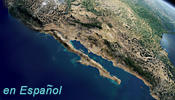![[Ocean Oasis Conservation]](images/bnr-conservation.gif)

![[Ocean Oasis Conservation]](images/bnr-conservation.gif) |  |
|
|

Possibly the most scenic of the islands of the bay of Loreto, Isla del Carmen has been for many years a favorite destination for ecologically-aware tourists, and plays a major role both in the reserve of the Islands of the Gulf of California in general, and in the National Park of the Bay of Loreto in particular. Based on the apparent success of the breeding program of the Sonoran Bighorn in Isla Tiburón, the National Institute of Ecology (INE) of the Mexican Federal Government decided to promote a similar program in Isla del Carmen. The Baja California bighorn subspecies (Ovis canadensis weemsi) is a highly endemic taxa that is only found in the Sierras El Mechudo, La Giganta, and Las Tres Vírgenes within the peninsula of Baja California. In 1995, a Mexican company, Salinas del Pacífico S. A., presented a project to recover the peninsular populations of bighorn by breeding them in the protected environment of Isla del Carmen.
The National Institute of Ecology supported the plan, and gave the company a permit to capture 15 adult bighorn, 12 females and 3 males, in the Sierra de El Mechudo. The plan establishes that when the herd reaches 175 individuals in an estimated time of 10 years, adults will be captured and used to repopulate the peninsular mainland. The plan, however, was received with certain criticism by conservationists in the peninsula for the following reasons:
Continue to |
|
Text adapted from the conservation chapter of the book Island Biogeography in the Sea of Cortés, a forthcoming volume edited by Ted Case, Martin Cody, and Exequiel Ezcurra. The chapter was authored by Luis Bourillon, Antonio Cantú, Exequiel Ezcurra, María Elena Martínez, and Alejandro Robles. |
Photograph by Bradford Hollingsworth
Conservation | Site Index | Ocean Oasis
San Diego Natural History Museum & PRONATURA
© 2000 CinemaCorp of the Californias